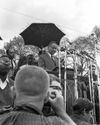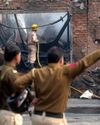
WARS HAVE A WAY of throwing the spotlight on labour relations—more so total wars, premised on men, munition and mobilisation. Key workers who are otherwise invisible at once become visible, not least because the working classes are critical to the prosecution of war. Yet, as the historian Radhika Singha shows, they are easily written out of history.
A flood of appreciation for the contributions of non-white soldiers to the Allied fight against the Central Powers filled the airwaves on the centenary of the First World War in 2014. Scarcely a murmur, however, was heard about their “followers”: those who worked as latrine cleaners, construction workers, mule drivers, stretcher-bearers, water carriers, gardeners, blacksmiths, cooks, grooms, laundrymen, porters and sweepers. It is the agency of this class that Singha uncovers in The Coolie’s Great War: Indian Labour in a Global Conflict, 1914-1921.
A professor at Jawaharlal Nehru University in Delhi, Singha made her name with a history of colonial criminal law in the subcontinent in the late eighteenth and early nineteenth centuries, in particular the tensions between its simultaneously metropolitan and native character. It is another tension, between combatants and non-combatants in an age when that distinction counted for less and less, that is at the heart of her latest book.
This story is from the April 2022 edition of The Caravan.
Start your 7-day Magzter GOLD free trial to access thousands of curated premium stories, and 9,000+ magazines and newspapers.
Already a subscriber ? Sign In
This story is from the April 2022 edition of The Caravan.
Start your 7-day Magzter GOLD free trial to access thousands of curated premium stories, and 9,000+ magazines and newspapers.
Already a subscriber? Sign In

Mob Mentality
How the Modi government fuels a dangerous vigilantism

RIP TIDES
Shahidul Alam’s exploration of Bangladeshi photography and activism

Trickle-down Effect
Nepal–India tensions have advanced from the diplomatic level to the public sphere

Editor's Pick
ON 23 SEPTEMBER 1950, the diplomat Ralph Bunche, seen here addressing the 1965 Selma to Montgomery March, was awarded the Nobel Peace Prize. The first black Nobel laureate, Bunche was awarded the prize for his efforts in ending the 1948 Arab–Israeli War.

Shades of The Grey
A Pune bakery rejects the rigid binaries of everyday life / Gender

Scorched Hearths
A photographer-nurse recalls the Delhi violence

Licence to Kill
A photojournalist’s account of documenting the Delhi violence

CRIME AND PREJUDICE
The BJP and Delhi Police’s hand in the Delhi violence

Bled Dry
How India exploits health workers

The Bookshelf: The Man Who Learnt To Fly But Could Not Land
This 2013 novel, newly translated, follows the trajectory of its protagonist, KTN Kottoor.